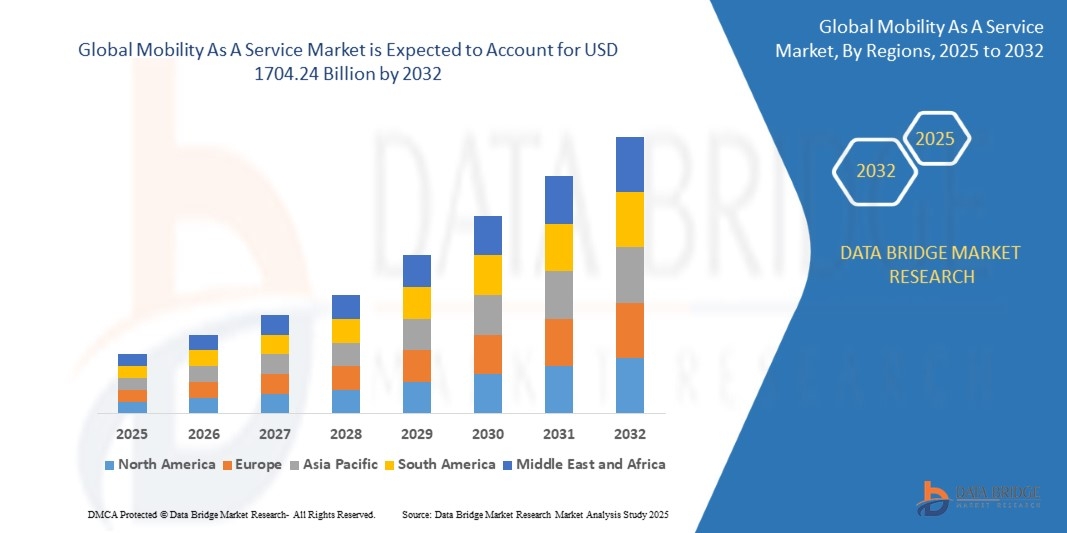Mobility as A Service Market Value with Status and Analysis 2032

"Executive Summary Mobility as A Service Market Research: Share and Size Intelligence
CAGR Value
During the forecast period of 2025 to 2032 the market is likely to grow at a CAGR of33.65%, primarily driven by rising demand for convenient, cost-effective, and flexible transportation options
Best-practice models and research methodologies have been employed in the reliable Mobility as A Service Market report for a complete market analysis. It is a completely informative and proficient report that highlights primary and secondary market drivers, market share, leading segments and geographical analysis. With this business report, it has been assured that an absolute knowledge and insights about the new regulatory environment which are most suitable for their organization are provided. Utilization of integrated approaches combined with most up-to-date technology for building this world class marketing report makes it unrivalled. The trends in consumer and supply chain dynamics are acknowledged in Mobility as A Service Market report to accordingly interpret the strategies about marketing, promotion and sales.
With the market info provided in the global Mobility as A Service Market report, it has become easy to gain global perspective for the international business. Focus groups and in-depth interviews are included for qualitative analysis whereas customer survey and analysis of secondary data has been carried out under quantitative analysis. This market research report acts as a very significant constituent of business strategy. This market report is a definite study of the Mobility as A Service Market industry which explains what the market definition, classifications, applications, engagements, and global industry trends are. Mobility as A Service Market report proves to be a sure aspect to help grow the business.
Find out what’s next for the Mobility as A Service Market with exclusive insights and opportunities. Download full report:
https://www.databridgemarketresearch.com/reports/global-mobility-as-a-service-market
Mobility as A Service Market Dynamics
**Segments**
- By Service Type: Based on service type, the Mobility as a Service market can be segmented into Ride Hailing, Car Sharing, Bike Sharing, Ride Sharing, and Others. Ride hailing services, like Uber and Lyft, are one of the most popular segments as they offer on-demand transportation services through mobile applications. Car sharing services allow users to access vehicles on a short-term basis, providing flexibility and cost-effectiveness. Bike sharing services have gained popularity in urban areas as a sustainable transportation option. Ride sharing services involve multiple passengers sharing a single vehicle to reach their destinations efficiently.
- By Vehicle Type: The market can also be segmented by vehicle type into Cars, Two-wheelers, and Others. Cars segment dominates the market as they are the most commonly used mode of transportation globally. Two-wheelers, including bikes and scooters, are gaining traction in densely populated cities due to their agility and environmental benefits.
- By Business Model: The Mobility as a Service market can be categorized by business model into Business-to-Business (B2B), Business-to-Consumer (B2C), and Peer-to-Peer (P2P). B2C model involves service providers offering transportation services directly to end consumers. B2B model caters to businesses and corporations that require transportation services for their employees. P2P model enables individuals to share their vehicles or offer transportation services to others through peer-to-peer platforms.
**Market Players**
- Uber Technologies Inc.: Uber is a prominent player in the Mobility as a Service market, offering ride-hailing services in numerous countries globally. The company has revolutionized urban transportation with its convenient and efficient app-based services.
- Lyft Inc.: Lyft is another key player in the market, providing ride-sharing services in the United States and select international markets. The company focuses on sustainability and has implemented various initiatives to reduce carbon emissions.
- DiDi Chuxing: DiDi is a leading mobility platform in China, offering a range of transportation services, including ride-hailing, bike-sharing, and car rental. The company has a strong presence in the Asia-Pacific region and continues to expand its services.
- BlaBlaCar: BlaBlaCar is a popular peer-to-peer carpooling platform that connects drivers with passengers traveling in the same direction. The company operates in Europe, Latin America, and Asia, providing an affordable and sustainable transportation option.
- Ola Cabs: Ola is an Indian-based ride-hailing company that has diversified its services to include car rentals, bike-sharing, and food delivery. The company is a major player in the South Asian market and competes with global giants like Uber.
The Mobility as a Service (MaaS) market is experiencing significant growth and evolution driven by rapid urbanization, increasing congestion, and the shift towards sustainable transportation solutions. One key trend shaping the market is the integration of various transportation services into a seamless, user-centric platform. MaaS providers are focusing on offering a comprehensive range of mobility options, including ride hailing, car sharing, bike sharing, and public transit, to meet the diverse needs of consumers. This integrated approach not only enhances the user experience but also promotes multimodal transportation and reduces individual car ownership.
Another important aspect influencing the MaaS market is the emergence of innovative technologies such as artificial intelligence, IoT, and blockchain. These technologies play a crucial role in improving the efficiency, safety, and sustainability of MaaS solutions. AI-powered algorithms are being utilized to optimize route planning, predict demand, and personalize services for users. IoT devices enable real-time tracking of vehicles, enhanced connectivity, and data-driven decision-making. Blockchain technology is being leveraged to ensure secure transactions, transparent data sharing, and decentralized governance in the MaaS ecosystem.
Furthermore, the regulatory environment is a key factor impacting the MaaS market dynamics. Governments worldwide are increasingly recognizing the potential benefits of MaaS in reducing traffic congestion, lowering emissions, and enhancing urban mobility. As a result, policymakers are implementing supportive regulations, incentives, and infrastructure investments to promote the adoption of MaaS solutions. However, challenges such as data privacy, interoperability, and fair competition among market players need to be addressed to ensure the sustainable growth of the MaaS ecosystem.
In terms of market competition, the landscape is characterized by both established players and new entrants vying for market share and differentiation. While global giants like Uber and Lyft have a strong presence in the market, regional players such as DiDi Chuxing and Ola Cabs are also expanding their offerings and geographical reach. The competition is driving innovation in service offerings, pricing strategies, and customer engagement to attract and retain users in an increasingly crowded market.
Looking ahead, the future of the MaaS market is likely to be shaped by factors such as the adoption of electric and autonomous vehicles, the integration of smart city initiatives, and the evolution of consumer preferences towards shared and sustainable mobility options. As MaaS continues to disrupt the traditional transportation landscape, collaboration among industry stakeholders, continued technological advancements, and strategic partnerships will be crucial in unlocking the full potential of integrated mobility solutions for a more efficient and sustainable urban transport ecosystem.The Mobility as a Service (MaaS) market is on a trajectory of significant growth and transformation as a result of various key trends and drivers. One of the primary trends shaping the market is the increasing emphasis on multimodal transportation solutions that cater to the diverse needs of consumers. MaaS providers are integrating different modes of transportation such as ride-hailing, car sharing, bike sharing, and public transit into a seamless platform, enhancing user experience and promoting sustainable mobility options. This user-centric approach not only improves convenience but also contributes to reducing individual car ownership and promoting eco-friendly transport alternatives, aligning with the global shift towards sustainability.
Moreover, the infusion of innovative technologies like artificial intelligence (AI), Internet of Things (IoT), and blockchain is revolutionizing the MaaS landscape. AI-powered algorithms are optimizing route planning, demand prediction, and service personalization, enhancing operational efficiency and customer satisfaction. IoT devices are enabling real-time vehicle tracking, connectivity improvements, and data-driven decision-making, ultimately enhancing the overall functionality and effectiveness of MaaS solutions. Blockchain technology is ensuring secure transactions, transparent data sharing, and decentralized governance within the MaaS ecosystem, fostering trust and reliability among users and service providers.
Additionally, the regulatory environment is playing a crucial role in shaping the dynamics of the MaaS market. Governments worldwide are recognizing the societal benefits of MaaS in mitigating traffic congestion, reducing emissions, and enhancing urban mobility. Consequently, policymakers are introducing supportive regulations, incentives, and infrastructure investments to facilitate the widespread adoption of MaaS solutions. However, challenges related to data privacy, interoperability, and fair competition among market players need to be addressed to ensure the sustainable growth and scalability of the MaaS ecosystem.
In terms of market competition, the MaaS landscape is characterized by a blend of established industry giants and emerging players striving for market dominance and innovation. While companies like Uber, Lyft, DiDi Chuxing, BlaBlaCar, and Ola Cabs have established their presence in the market, the competition is driving continuous advancements in service offerings, pricing strategies, and customer engagement strategies. The future of the MaaS market is poised for further evolution with the anticipated adoption of electric and autonomous vehicles, integration of smart city initiatives, and evolving consumer preferences towards shared and sustainable mobility options. Collaboration among industry stakeholders, ongoing technological advancements, and strategic partnerships will be pivotal in unlocking the full potential of integrated mobility solutions for a more efficient and sustainable urban transport ecosystem.
Track the company’s evolving market share
https://www.databridgemarketresearch.com/reports/global-mobility-as-a-service-market/companies
Master List of Market Research Questions – Mobility as A Service Market Focus
- How large is the addressable market in terms of volume?
- What is the average revenue per user (ARPU)?
- How many startups are entering the Mobility as A Service Market yearly?
- What are the growth drivers in developing economies?
- What is the impact of e-commerce on this Mobility as A Service Market?
- What consumer preferences are influencing product design?
- Which demographic segments are being targeted?
- How are supply chains evolving in this Mobility as A Service Market?
- Which regions are witnessing price wars?
- What is the typical lifecycle of a product in this Mobility as A Service Market?
- How sustainable is the production process in this Mobility as A Service Market industry?
- Which companies have increased R&D spending?
- What impact does inflation have on demand?
- How do marketing strategies vary globally Mobility as A Service Market?
Browse More Reports:
Global Vegan Ice-Cream Market
Global Dumbbells Market
Middle East and Africa Lithium Ion Battery Market
North America Orthodontic Supplies Market
Global Digital Light Processing Chipset Market
Global Chilaiditi’s Syndrome Market
Global 3rd Generation Lentiviral Vector Market
Global Vinyl Glove Market
Europe Ataxia Market
Asia-Pacific Lithium Ion Battery Market
Global Cold Chain Market
Global Ewing Sarcoma Drug Market
Asia-Pacific Scleroderma Therapeutics Market
Global Digital Map Market
Global Cancer Tumor Profiling Market
Global RF Over Fiber Market
Global Wireless Access Point Market
Global Production Chemical Market
Middle East and Africa Scleroderma Therapeutics Market
Global Sustainable Paper Packaging Market
Asia-Pacific Automated Cell Cultures Market
About Data Bridge Market Research:
An absolute way to forecast what the future holds is to comprehend the trend today!
Data Bridge Market Research set forth itself as an unconventional and neoteric market research and consulting firm with an unparalleled level of resilience and integrated approaches. We are determined to unearth the best market opportunities and foster efficient information for your business to thrive in the market. Data Bridge endeavors to provide appropriate solutions to the complex business challenges and initiates an effortless decision-making process. Data Bridge is an aftermath of sheer wisdom and experience which was formulated and framed in the year 2015 in Pune.
Contact Us:
Data Bridge Market Research
US: +1 614 591 3140
UK: +44 845 154 9652
APAC : +653 1251 975
Email:- corporatesales@databridgemarketresearch.com
"
- Art
- Causes
- Crafts
- Dance
- Drinks
- Film
- Fitness
- Food
- Giochi
- Gardening
- Health
- Home
- Literature
- Music
- Networking
- Altre informazioni
- Party
- Religion
- Shopping
- Sports
- Theater
- Wellness

